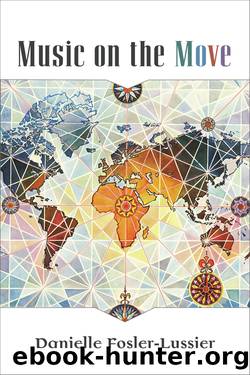Music on the Move by Danielle Fosler-Lussier

Author:Danielle Fosler-Lussier [Fosler-Lussier, Danielle]
Language: eng
Format: epub
Tags: MUS024000 Music / Genres & Styles / International
Publisher: University of Michigan Press
Published: 2020-06-22T00:00:00+00:00
Harrisonâs blending of elements makes this music a representative of no one tradition: it is an effort to combine beautiful sounds from different traditions, making what Harrison called âplanetary music.â28
Harrison has been criticized for borrowing only the distinctive sounds from non-Western musics: he typically did not borrow overall organizational plans. Even the sounds were altered in the process of borrowing, as Harrison rebuilt the instruments. Harrison did not seek to transform his listenersâ consciousness by asking them to hear music in unaccustomed ways, as Riley did. Rather, Harrison organized sounds within the musical structures typical of Western art music and within the social structure of the Western concert setting.29 Much like Claude Debussy, Harrison expected his listeners to rejoice in the new sounds and in the sense of affiliation with foreign peoples those sounds brought with them. By borrowing sounds, Harrison was not trying to recreate other kinds of music faithfully; indeed, his music includes elements that would not otherwise have been heard side by side. Yet the way he used these sounds from afar purposefully evokes a sense of âforeignness,â reminding the listener that other worlds and ways of being are possible.
We might think of Harrisonâs strategy as trying to use positive elements of exoticism without the negative ones. The historian Christina Klein has described Americansâ fascination with Asia in the 1950s and 1960s. US involvement in Asia during World War II, the Korean War, and the Vietnam War ensured that the idea of Asia was ever-present for Americans, not only in the news but also in popular culture. Musicals such as The King and I and South Pacific presented stereotypical clashes of Asian and Western characters who seemed irredeemably different from one another.30 But Americans who wanted to criticize US military actions in Asia found in Asian music an appealing resource for expressing solidarity with Asian people. By adopting elements of Asian musics as their own, Riley and Harrison made personal statements reflecting this political commitment.
In the music of Olly Wilson (1937â2018) we can hear a complex working-out of self-definition with respect to multiple musical traditions. Wilson, a scholar and a composer, held a PhD in music composition. He spent a year in West Africa in the early 1970s, and he wrote articles analyzing similarities Page 165 âbetween the music of West Africa and that of African Americans. As an African American who belonged to the generation after the Harlem Renaissance, Wilson chose to connect to the African American tradition and to consider what about his American life has any connection with Africa. Like many members of his generation Wilson was particularly inspired by pan-Africanismâthe idea that Africans and members of the African diaspora share a common heritage.
In 1976 Wilson composed a piece called Sometimes for a singer and tape: the tape contains electronic noises and voices. This piece is based on the concert spiritual âSometimes I Feel like a Motherless Child,â which we heard in example 3.9. In Sometimes Wilson manipulates the spiritual in various ways. Sometimes
Download
This site does not store any files on its server. We only index and link to content provided by other sites. Please contact the content providers to delete copyright contents if any and email us, we'll remove relevant links or contents immediately.
The Goal (Off-Campus #4) by Elle Kennedy(12433)
Kathy Andrews Collection by Kathy Andrews(10519)
Diary of a Player by Brad Paisley(6866)
What Does This Button Do? by Bruce Dickinson(5527)
Assassin’s Fate by Robin Hobb(5236)
Big Little Lies by Liane Moriarty(4880)
Pale Blue Dot by Carl Sagan(4001)
Sticky Fingers by Joe Hagan(3454)
The Heroin Diaries by Nikki Sixx(2931)
The Death of the Heart by Elizabeth Bowen(2901)
Beneath These Shadows by Meghan March(2718)
The Help by Kathryn Stockett(2704)
Confessions of a Video Vixen by Karrine Steffans(2674)
How Music Works by David Byrne(2525)
Jam by Jam (epub)(2489)
Harry Potter 4 - Harry Potter and The Goblet of Fire by J.K.Rowling(2416)
Strange Fascination: David Bowie: The Definitive Story by David Buckley(2367)
Petty: The Biography by Warren Zanes(2237)
Darker Than the Deepest Sea by Trevor Dann(2206)
